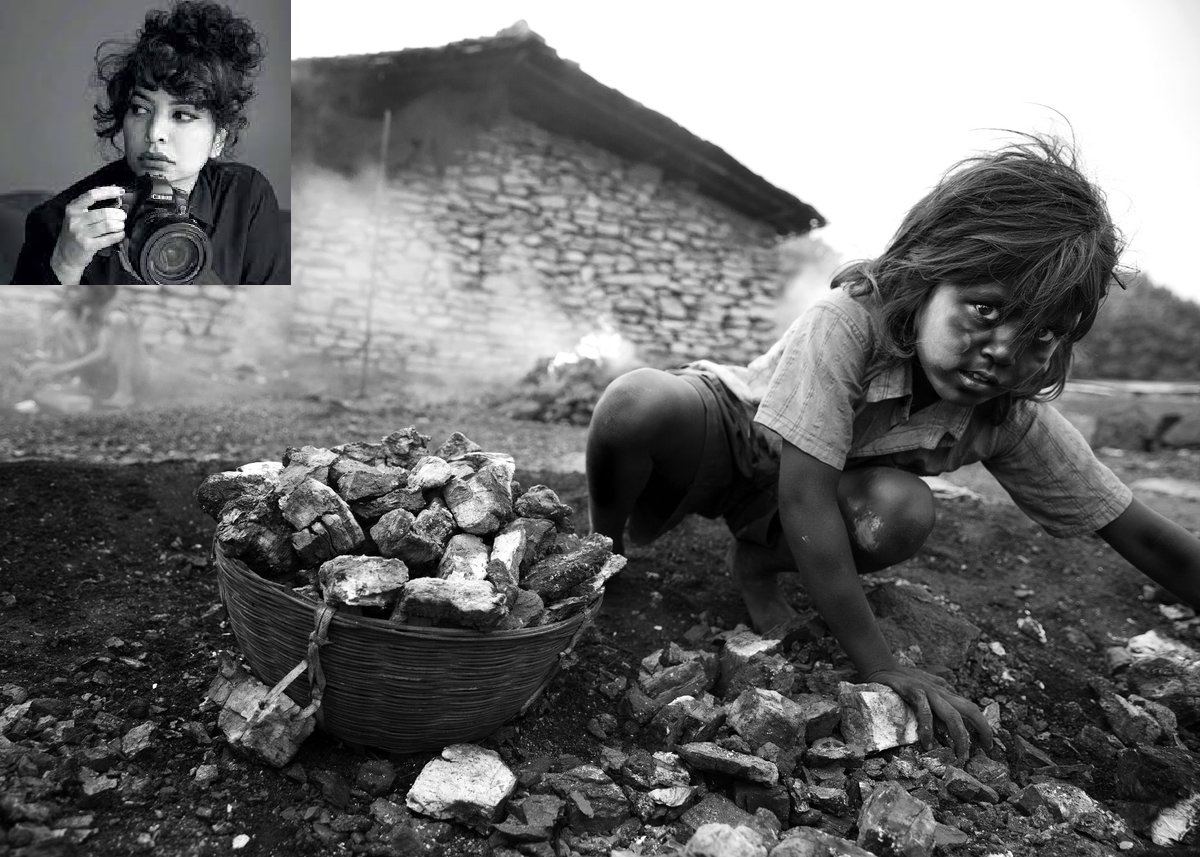INDIA. Asha Thadani’s photo exhibition zooms in on dark lives of the Dalits
 The slanting rays of light fall on her coalsmudged face. She is just about four years old but her life, as a member of a bonded Dalit family digging for coal in the Jharia coal mines of Jharkhand, is devoid of hope, future, or redemption. In another poignant image, the word ‘Ram’ is tattooed across the face and body of an elderly lady as if they were designs meant to add lustre to her stoic beauty This old graceful lady is a Ramnami Dalit, a community whose members have Ram tattooed across the body, following a longstanding tradition of protest against the upper castes dating back to the late 19th century- when Parasuram Bhardwaj, a Dalit from Charpara village in Chhattisgarh, was barred from entering a temple. Despite the passage of time, the tradition and the tattoos have survived. These Ram tattoos show devotion and defiance in a completely stunning way.
The slanting rays of light fall on her coalsmudged face. She is just about four years old but her life, as a member of a bonded Dalit family digging for coal in the Jharia coal mines of Jharkhand, is devoid of hope, future, or redemption. In another poignant image, the word ‘Ram’ is tattooed across the face and body of an elderly lady as if they were designs meant to add lustre to her stoic beauty This old graceful lady is a Ramnami Dalit, a community whose members have Ram tattooed across the body, following a longstanding tradition of protest against the upper castes dating back to the late 19th century- when Parasuram Bhardwaj, a Dalit from Charpara village in Chhattisgarh, was barred from entering a temple. Despite the passage of time, the tradition and the tattoos have survived. These Ram tattoos show devotion and defiance in a completely stunning way.
Such searing and stunning black and white portraits from ten Dalit communities across India are the subject of a superb and unsettling photography exhibition, titled “Broken: Dalit Lives,” by Bengaluru-based photographer Asha Thadani, on at the open central atrium of the Indian Habitat Centre in Delhi till January 7, 2024. The exhibition has earned critical acclaim since it began on November 23.
“There is not much colour in their lives. Life is so bleak for them. Everything is black, and there is a bit of white,” the 48-year-old Thadani says about the black and white photographs. The photographs emerged from Thadani’s documentary work on the tribals of India, which she has been involved with for a decade now.
Documenting life beyond the margins
These pictures of life beyond the margins capture and evoke a range of emotions: empathy, defiance, anger and, of course, shame. In the series on Haleyas or goat head butchers, there are young men, with their faces, all black with the smoke and glittering with sweat, looking out towards you as if they have reconciled with their tortuous destiny: to harvest brain from the head of butchered goats. Their faces are alive and often sparkling, but there is no hope or desire in them. As if the goat heads lying all around them are a reflection of their own destiny.
Their life expectancy is 35 to 45 years since they are exposed to toxic smoke and coal dust from the furnaces for 12 hours a day near or behind meat markets, taking out the brain from the skull of goats. In the hierarchy of butchers, the Haleyas come on the lowest rung; they are not allowed to deal with the prime cuts of meat nor even the offal, for which there are people from different castes, both among the Hindus and Muslims.
“I choose the situation I want to photograph. My subjects need to know they are being photographed. They have to be aware of the process and understand that their dignity is not being compromised. It is a very intimate experience,” Thadani told The Federal. Thadani shoots with standard lenses, like 18- 55 mm, so as not to intimidate her subjects with tele lenses and heavy equipment and lights.
There are many who are critical of such work. Sudharak Olwe, Mumbai-based news photographer who has done tremendous work in photographing sewage workers mostly in Mumbai, wrote in a post on Facebook: “These photos and others in the series are an exploitation of the lives of our Dalit communities. This is nothing but blatant exoticism of the pain and suffering of Dalit people…Photographers have to be sensitive and not sensational.”
Thadani brushes aside such criticism, underlining that she has taken special care not to compromise their dignity. Also, the photos are shared with her subject. Her photos are not for sale and clearly show her empathy towards the subject. Also, no one is made to pose or do anything in a certain way. Thadani has shown tremendous patience with her subjects and feels they need to know they are being photographed: “They have to be aware of the process.”
Thadani is also a commercial photographer.
She has shot for top brands and for all major ad agencies. That is a different world far away from the stark poverty and distress of Dalit lives. But Thadani strides both these worlds effortlessly, not an easy job at all. To inhabit two diverse worlds, one of manufactured sophistry and glamour and another of relentless struggle on the margins of life, is unimaginable. High walls of social biases, casteists biases divide these worlds. “One has led to the other,” she says.
Whichever way we look at it, ‘Broken’ brings alive a crucial and forgotten segment of our society. These are pictures we wish we hadn’t seen for we love to forget life at the margins. It is a documentarist’s job to go there and show it to us. Lest we forget forever.
Source: The Federal





